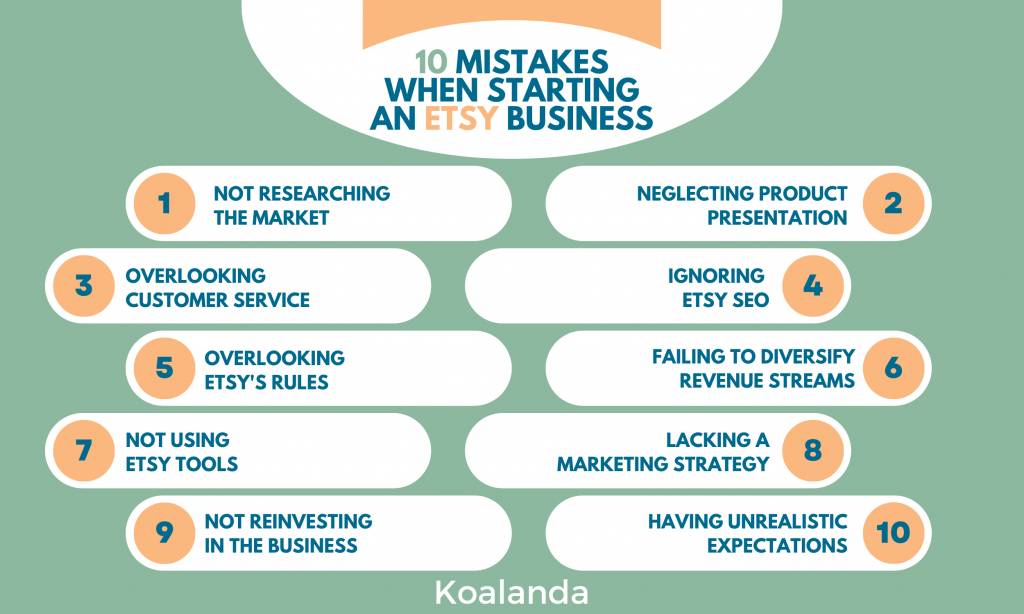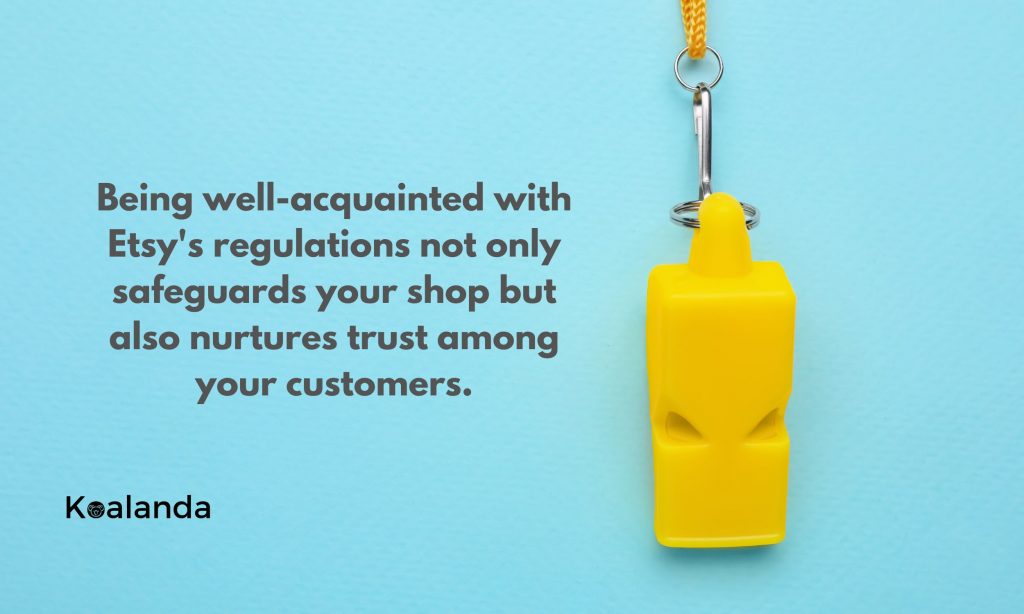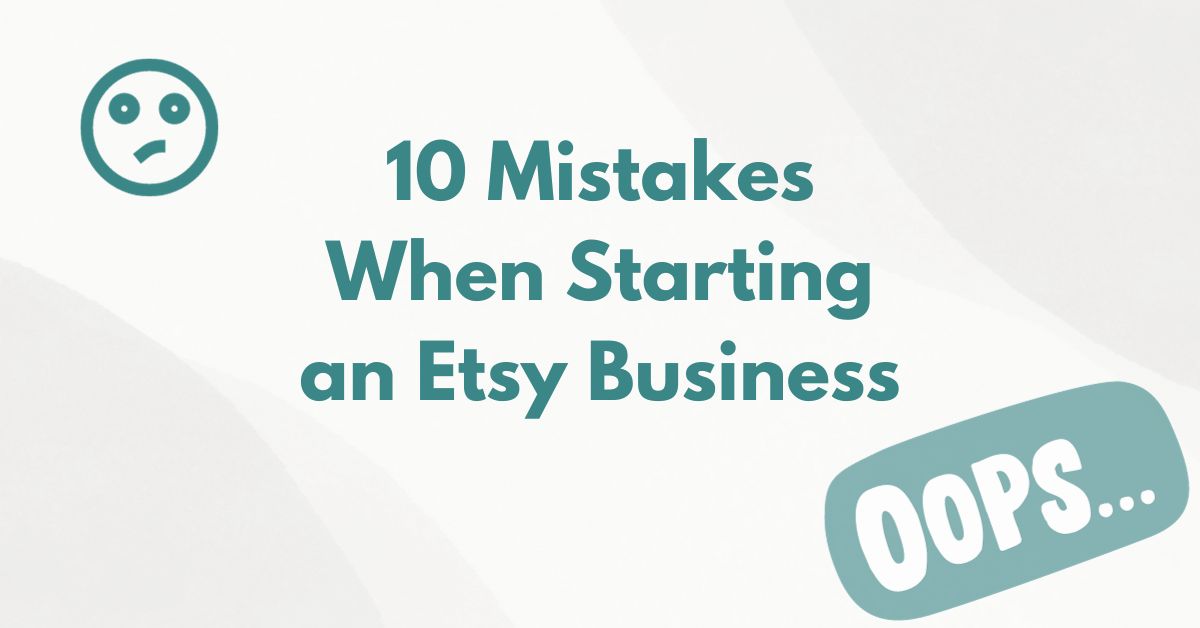Starting an Etsy shop can be an exciting venture. Whether it’s a passion project or a full-blown business aspiration, Etsy provides a platform for artisans to showcase their creations to a global audience. However, as with any entrepreneurial endeavor, there are pitfalls to avoid and strategies to embrace. This guide dives into some common mistakes Etsy sellers often make and offers insights on how to navigate the bustling marketplace more effectively.

Table of Contents
Not researching the market
Starting an Etsy shop is exciting, especially when you’re selling things you love. But loving your products isn’t enough for a successful business. It’s crucial to know what customers are actually looking for. You can’t just hope people want what you’re selling; you need to find out what they’re already searching for.
Doing proper market research helps a lot. This means looking at trends and seeing what’s popular. When you match your products with what buyers want, you increase your chances of making sales. It’s a balance between selling what you love and what’s in demand. By understanding the market, you set your Etsy shop on the path to success.
Market and product research can be done efficiently only if it is based on real data. With Koalanda’s Etsy Product Research tools you can easily find trending products, explore new product niches, and analyze competitor shops and listings.
Neglecting product presentation
Gone are the days when Etsy was simply a casual marketplace for hobbyist artists reaching a select group of customers. Today’s Etsy landscape has evolved dramatically. It’s no longer just about crafting; it’s about presenting.
Most top-performing Etsy shops now operate like legitimate businesses. Behind those beautiful handcrafted items are professional presentations that captivate potential buyers. Being an artist isn’t just about creating; it’s about showcasing your creation in the best light.
This means investing in high-quality photos that highlight every intricate detail of your product. It’s about crafting clear, concise descriptions that not only inform but also engage. And, professionalism extends beyond the product. Your shop policies, return guidelines, and even response times play a role in how customers perceive you.
In the vast Etsy marketplace, standing out requires more than just unique products. If you’re not presenting professionally, you risk blending into the background. Remember, a great product deserves a great presentation.
Overlooking customer service
Etsy isn’t just a platform to showcase products; it’s a space to build relationships. Customer service plays a pivotal role in the success of your shop.
Being prompt and professional in your interactions is paramount. Whether it’s addressing inquiries or providing post-sale support, timely responses matter. Etsy recognizes this, emphasizing its importance in their Star Seller program criteria.
Handling feedback, especially negative ones, requires tact. If a buyer leaves a less-than-stellar review, reach out. Understand their concern, and try to resolve it. Often, a proactive approach can lead to the revision of a negative review. But if resolution isn’t possible, your response to the feedback is still vital. Craft it with future customers in mind, ensuring they see your commitment to service, even in challenging situations.
In the digital realm of Etsy, your written interactions shape your brand. Make every interaction count.
Ignoring Etsy SEO
Etsy is bustling with talented sellers, which means grabbing a buyer’s attention isn’t always easy. That’s where Etsy SEO comes into play.
SEO, or Search Engine Optimization, is what helps your products pop up when buyers search. By understanding Etsy’s search algorithm, you can optimize your listings to appear more often and in better positions.
It’s not just about adding popular keywords. It’s about understanding the core concepts of Etsy SEO and implementing strategies that make your listings shine.
Overlooking this crucial aspect can bury your listings among thousands of others. To truly thrive on Etsy, delve into its SEO workings. It’s a game-changer for reaching more customers and boosting sales.
Overlooking Etsy’s rules
Etsy isn’t just a free-for-all marketplace. It has clear essential rules sellers must adhere to, and not paying attention to these can lead to swift consequences, including having your shop closed down.
Many of Etsy’s rules are straightforward. For instance, selling prohibited items like weapons is a no-go. Similarly, infringing on someone else’s intellectual property rights can get you in hot water.
However, some rules might not be so obvious at first glance. For sellers targeting customers in the European Union, you must accept returns. This might be surprising to some but is a must for selling within that region.

In essence, while Etsy provides a fantastic platform to showcase and sell, it’s imperative to be well-acquainted with its regulations. This knowledge doesn’t just protect your shop; it fosters trust with your customers.
Failing to diversify revenue streams
While Etsy is a powerful platform for sellers, relying solely on it can be a risky move. Just as with any business, diversifying your sources of income is essential for long-term stability.
Consider this: if Etsy undergoes significant changes, experiences technical issues, or shifts its algorithm in a way that impacts your sales, having all your eggs in the Etsy basket could lead to substantial revenue loss.
Diversifying doesn’t mean leaving Etsy, but rather expanding your presence. This could mean setting up your own independent website, selling on other online platforms, or even exploring offline avenues like local craft fairs or pop-up shops.
One of the most popular alternative platforms for Etsy sellers is eBay. You can read a direct comparison between the two platforms in our dedicated article about selling on Etsy vs eBay.
Not using Etsy tools
With a vast sea of over 6 million sellers on Etsy, standing out becomes a genuine challenge. To rise above, you need more than just creativity; you need strategy.
Tools like Koalanda offer a significant advantage. They help identify profitable niches, perfect your keyword research, and even peek into what competitors are doing. This kind of insight isn’t just useful – it’s essential.
Choosing to operate without these tools is like navigating a busy market blindfolded. You miss out on valuable data that could propel your store to greater heights.
In the competitive world of Etsy, every edge counts. By embracing the available tools, you ensure your business decisions are informed, giving you a leg up on the competition.
Lacking a marketing strategy
Etsy isn’t just a hobby platform; it’s a place for real businesses. And like any serious business, success hinges on having a solid marketing plan.
Simply listing products and waiting for sales won’t cut it. Consider the marketing tools that Etsy offers – Etsy ads, offsite ads, sales and discount coupons. These features can increase your shop’s visibility, driving more traffic and sales.
But don’t stop at Etsy. Building an email list can be a goldmine, keeping your customers engaged and informed about new products or promotions. Social media is also key. Whether it’s Facebook, Pinterest, or TikTok, each platform offers a unique way to showcase your products and connect with potential buyers.
Not Reinvesting in the business
Success on Etsy requires more than just making sales. It’s vital to put some of those earnings back into the business. Reinvesting helps in various ways, like improving your tools, updating your skills, or expanding your marketing efforts.
Trends and customer demands change. To keep up, you might need better equipment or new training. As your shop grows, you could face higher costs for things like inventory or shipping. By reinvesting, you ensure you’re prepared for these changes.
In short, see reinvestment as your business’s growth tool. It helps keep your shop fresh, relevant, and competitive.
Having unrealistic expectations
Etsy’s popularity has skyrocketed in recent years. More sellers are flocking to the platform than ever before. While this means more variety, it also means more competition.
It’s a mistake to think you’ll stand out easily. With the surge in sellers, some niches are packed. Yes, there are more buyers, but they’re not growing at the same pace as sellers.
Many dream of making Etsy their primary source of income. Yet, the truth is, only a handful really thrive. Success doesn’t come easy; it demands consistent effort, patience, and commitment.

Jumping into Etsy with dreams of instant wealth will only lead to disappointment. Instead, approach it with patience, understanding that building a successful store takes time. Craft with passion, market with strategy, and keep realistic goals.
Conclusion
Etsy is a vibrant marketplace brimming with potential. But to truly succeed, understanding the intricacies of the platform is essential. By avoiding the pitfalls mentioned above and leveraging the recommended strategies, you can set your Etsy shop up for sustained success. Remember, every successful seller started somewhere, and with dedication, continuous learning, and a touch of creativity, your store can shine brightly amidst the competition.





